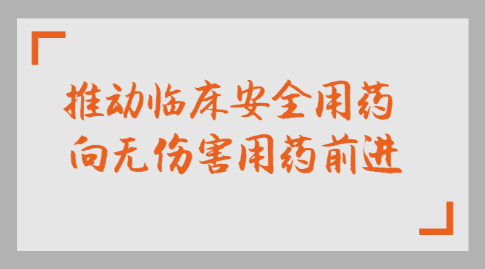From October 10th to November 9th this year, it is "2017 Safe Drug Month", and the safety of medication has caused close attention of all parties. From October 21st to 22nd, the 5th International Forum on Drug Safety was held in Beijing. The meeting analyzed the data changes and causes of the clinical safety drug monitoring network in China, and released the "Injection Label Design Guide (Draft for Comment)" and 10 high-warning drug management strategies. Professor Wang Yuqin from the Pharmacy Department of Xuanwu Hospital of Capital Medical University pointed out at the forum that China is organizing, practicing and producing clinically safe drugs.

China has carried out a number of safe drug practice
Drug safety is an international issue. The World Health Organization (WHO) report shows that the annual cost of medication errors is as high as $42 billion, accounting for almost 1% of the total global medical expenses. Therefore, at the second Global Summit on Patient Safety Summit held in March this year, WHO launched a work to ensure patient safety – Medication Without Harm. On this basis, WHO launched A campaign to raise public awareness of the safety of drug use and awareness of the use of safer drugs to reduce the risk of drug use caused by unsafe drug use practices and misuse of drugs, and hope that within the next five years, Severe avoidable drug damage worldwide is reduced by 50%.
In recent years, China has carried out a number of safe drug use practices, including the establishment of a clinical safety drug group in the China Center Group for the rational use of drugs, and the establishment of a clinical safety drug monitoring network. Wang Yuqin participated in related work. According to her, 927 medical institutions in 25 provinces and municipalities have participated in the monitoring of safe drug use, and the number of reported cases of medication errors (ME) has increased from 1459 cases in 2013 to 9554 cases in 2017. Up to 25,119 cases, of which 76% of the ME belong to the B level 1, no harm to the patient. Statistics show that most of the medication errors occur in the drug delivery, drug delivery and medication guidance. In 2016, the number of ME reports in this session was 289, accounting for 80% of the technical ME report. However, with the hospital pharmacist's further attention to safe medication, the situation has changed. In 2017, the ME report of this link was 208 cases, accounting for 77%.
According to the data of the past two years, the top five rankings of the reported error content growth rate are drug specifications, drug delivery technology, leakage administration, indications and compatibility. It is worth noting that with the promotion and use of automatic dispensing machines, the number of MEs caused by inaccurate drug delivery has increased, and the number of reported cases has increased from 6 in 2016 to 59 in 2017, with a growth rate of over 883%.
formula
Improve LSA drug packaging prevention medication error
LASA drugs (similar in drug name and similar appearance) are important components for clinical safety drug monitoring. Wang Yuqin gave a "Top 10 most troublesome LASA drug list" (2012.6.30-2015.6.30), five of which are insulin injections, which are prone to variety and specification errors.
Insulin medication errors have also attracted the attention of the American Medical Safety Association (USISM). Mike Cohen, president of the US ISMP, said that insulin dosage form errors have also led to numerous drug safety incidents in the United States and have been heavily monitored. He believes that as drugs move around the world, international exchange of medication safety information is increasingly important.
There are many lessons to be learned from abroad in the prevention of LSA drug use errors. The practice in the United States is mainly to educate doctors and patients, conduct drug name labeling, use the drug information barcode technology to automatically deploy and set up computer early warning procedures, including evaluating the unit's drugs, establishing the LASA drug catalog, tracking the design of LASA medication errors and conducting Employee education, using the generic name and trade name of the drug at the same time, the similar drugs are stored separately, the doctor conducts oral advice, explains the purpose of the drug, and recommends that the patient check the drug label before using the drug, and so on.
In China, the selection and management of high-alert drugs, the setting of high-warning drug labels, and the development of training and education have been adopted to reduce the incidence and harm of drug use errors in LASA drugs, and the use of drugs has been improved. Taking Beijing as an example, in 2013, a total of 2021 ME reports were reported in Beijing, of which 549 cases were caused by LSA, accounting for 27.2%. However, through the above practice, the ratio has dropped to 11% in 2015 and further dropped to 8.8% in 2016.
Efforts to prevent LDA drug use errors in the industry have not stopped. In this forum, China Pharmaceutical Packaging Association and other joint publication of the "Injection Label Design Guide (Draft for Comment)", drawing on the design of foreign injection label, promoting the safe design of China's pharmaceutical packaging, reducing the similar packaging, key data labeling Improper medication caused by unclear reasons. “Through drug packaging design research, it has achieved the effects of promoting drug safety, improving patient experience and compliance,†said Zhang Xiaole, one of the project participants and former deputy director of the Pharmacy Department of Peking University Third Hospital.
(Note 1: According to the medication error and the degree of damage caused, the ME grade is divided into four levels: the first level is error-free, level A; the second level is error-free, including B, C, D; The third level is faulty and harmful, including E, D, G, and H levels; the fourth level is error-causing, which is level I.)
Tetanus Shot,Tetanus Vaccine,Hepatitis B Injection,Hep B Vaccine
FOSHAN PHARMA CO., LTD. , https://www.forepharm.com